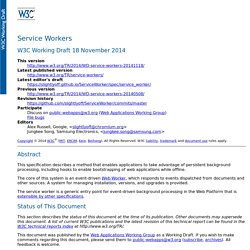

Is WebRTC ready yet? WebRTCfest: Online WebRTC Hackathon. Interview : WebRTC, le standard de communication prometteur mais encore méconnu. À minuit débutera le WebRTCfest, un hackathon en ligne autour du standard de communication WebRTC.

Arnaud Budkiewicz, l'organisateur de cet événement, également évangéliste WebRTC, membre du W3C et cofondateur de Bistri (une entreprise spécialisée dans ce domaine), nous explique l'intérêt de cette technologie et son état d'avancement. MacGeneration : Qu'est-ce que WebRTC ? S'agit-il d'un concurrent direct de Skype, FaceTime et Hangouts ? Arnaud Budkiewicz : WebRTC est le tout premier standard élaboré au W3C et à l’IETF pour normaliser les communications en temps réel peer-to-peer. Concrètement, il couvre les appels vidéos, audio, et les échanges de données. Skype, FaceTime et Hangouts sont d’excellents produits propriétaires, mais dont le fonctionnement reste totalement obscur. Qui soutient et développe cette technologie ? Où en est la prise en charge de WebRTC dans les navigateurs aujourd'hui ? WebRTC Plugins - Temasys WebRTC Plugin Public Documentation - Temasys Documentation.
03 Sept, 2014 Adapter.js, version 0.9.0 namespacing of the plugin, the webrtc interface stays the same, you dont' need to change your codeAll Temasys related code is located in All plugin related code is located in You should now access the plugin through Temasys.WebRTCPlugin.TemRTCPluginTwo different injection strategies for IE 9 (or less) and any other browsernew popup offering to install the pluginWebRTCReadyCb is deprecated, you should remove it from you code.

You may now call any webrtc function at any time.If the plugin is not ready, your javascript will either wait until the plugin it is or launch an interval when possible. Please note that you don't HAVE to upgrade your version of the adapter to upgrade your plugin. However, this new version bring a number of improvements, and we really think you should . Please note that our examples are using the latest version of the adapter. The offline cookbook - JakeArchibald.com. When AppCache arrived on the scene it gave us a couple of patterns to make content work offline.

If those were the patterns you needed, congratulations, you won the AppCache lottery (the jackpot remains unclaimed), but the rest of us were left huddled in a corner rocking back & forth. With ServiceWorker (intro) we gave up trying to solve offline, and gave developers the moving parts to go solve it themselves. It gives you control over caching and how requests are handled. That means you get to create your own patterns. Let's take a look at a few possible patterns in isolation, but in practice you'll likely use many of them in tandem depending on URL & context. All code examples work today in Chrome 40 beta with the cache polyfill, unless otherwise noted. For a working demo of some of these patterns, see Trained-to-thrill, and this video showing the performance impact. Contents The cache machine - when to store resources On install - as a dependency. Introduction to Service Worker: How to use Service Worker. Rich offline experiences, periodic background syncs, push notifications— functionality that would normally require a native application—are coming to the web.

Service workers provide the technical foundation that all these features will rely on. What is a Service Worker? A service worker is a script that is run by your browser in the background, separate from a web page, opening the door to features which don't need a web page or user interaction. Today, they already include features like push notifications and in the future it will include other things like, background sync, or geofencing. The core feature discussed in this tutorial is the ability to intercept and handle network requests, including programmatically managing a cache of responses. The reason this is such an exciting API is that it allows you to support offline experiences, giving developers complete control over what exactly that experience is.
Things to note about a service worker: Service Worker Lifecycle Before We Start. Service Workers. This specification describes a method that enables applications to take advantage of persistent background processing, including hooks to enable bootstrapping of web applications while offline.

The core of this system is an event-driven Web Worker, which responds to events dispatched from documents and other sources. A system for managing installation, versions, and upgrades is provided. The service worker is a generic entry point for event-driven background processing in the Web Platform that is extensible by other specifications. This section describes the status of this document at the time of its publication. Other documents may supersede this document.
Publication as a Working Draft does not imply endorsement by the W3C Membership.